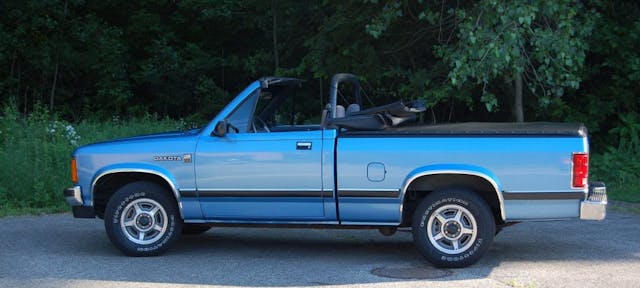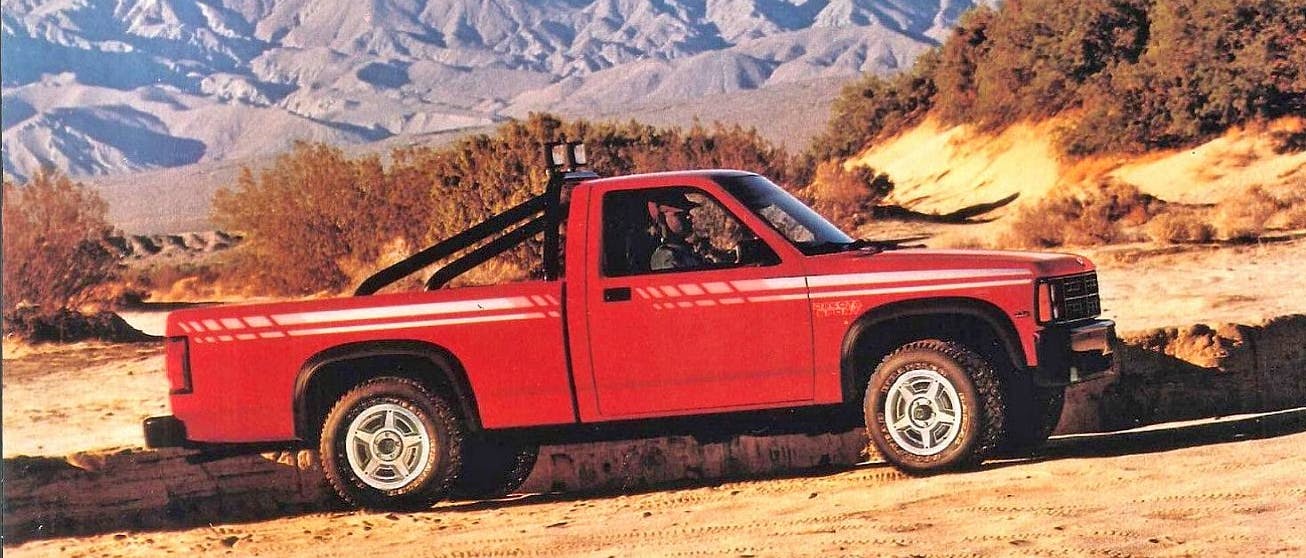Media | Articles
The 1987 Dodge Dakota was a true segment buster
Dodge Dakota: founder of the mid-size truck segment. No, the story of this pickup isn’t quite a star-crossed, semi-tragic proto-CUV tale in the vein of the AMC Eagle, but the history of any segment-buster is worthy of discussion and appreciation. Remember, the American truck circa 1987 wasn’t the domineering sales force it is today, though its profits were still juicy and easier to produce due to looser regulations. But back then it wasn’t easy to find an extended-cab example, much less a legit crew-cab, four-door rig. And good luck finding one with options worthy of a nicely loaded Cadillac! Ah, the good ol’ days.
Back to the mid-size rig from Dodge. The fine folks at Motorweek got their hands on a 1987 Dodge Dakota with the optional 8-foot bed, V-6 engine, 2500-pound payload, automatic transmission, and the upscale LE trim package. This configuration is the mid-size truck’s primary value proposition, offering the carrying capacities of a big truck with a smaller footprint akin to the compacts available from GM and Ford. And much like the Chevrolet S-10’s 4.3-liter mill, the Dakota’s 3.9-liter V-6 is based on Chrysler’s 318-cu-in small-block V-8. While Motorweek didn’t much care for the V-6’s NVH characteristics, the lack of balance shafts might have been overshadowed by subsequent power and efficiency improvements (like EFI in 1988).
Handling was improved over that of larger rigs, partly due to the Dakota’s smaller size and utilization of passenger-car suspension components. Thanks to one Hal Sperlich, the Dakota was a masterpiece of parts-bin engineering. No, really—it’s a good thing, just like Hal’s two vehicular claims to fame: the Chrysler Minivan and Ford Mustang. While it’s hard to remember just how prevalent the regular-cab configuration was on American roads back then, the Dakota’s interior clearly offered a step up from competing compact trucks, especially if three people needed transport. With the LE’s upgraded trim, plasti-wood trim, cup holders, and velour seat fabrics, Dodge was experimenting early with a strategy that would practically print money for automakers in the future: selling upscale versions of yeoman fleet vehicles. Future Dakotas had it all: bucket seats, leather-wrapped steering wheels, upgraded audio systems, an eight-cylinder performance upgrade from Carroll Shelby, and even a folding soft top just to give the business model the shiniest of auras for its halo effect.

Back to that “looser regulations” comment in the first paragraph: While the 1970s emissions regulations saw manufacturers finding “interesting” ways to skirt the law (cough, Big 10/Heavy Half) I doubt most folks would snub the gubment for mandating headrests on trucks, especially those with a sheet of glass right behind the occupant’s head. No matter, it’s a proper thing for Motorweek to have noted the ridiculousness of the Dakota’s low bench seat, and—mercifully—future Dakotas addressed this concern.

Truck safety might have been an oxymoron in decades past, but smaller, more city-friendly trucks like the Dodge Dakota suggested these rigs would indeed meet urban roads, traffic congestion, and require more safety equipment. These were turning into lifestyle vehicles, before those two words became a cringeworthy marketing phrase.
Marketplace
Buy and sell classics with confidence

While the death of the Dodge Dakota in 2011 was an unceremonious event for most, it’s an odd state of affairs to see the midsize genre get a reboot thanks to the second-generation Chevrolet Colorado (GMT 31XX platform), Ford Ranger (T6 platform), and Toyota Tacoma (N-200 platform). The concept clearly had merit, as the first two generations of Dodge’s Dakota’s netted yearly sales that regularly landed in the six-figure category. More to the point, that’s about how well the Colorado and Ranger perform these days. But perhaps these newcomers are no longer vulnerable to the full-size-truck forces that killed the Dakota: modest pricing differentials, incentives that often broke five-figures, cheap fuel, and larger R&D budgets to go with those bigger bodies.
What about the sales of compact trucks, you say? They were a force to be reckoned with in the 1980s, and Ford’s already got a winner on their hands with the Maverick.
We've now hit 100,000 reservations on the all-new Maverick, our compact truck with standard hybrid engine. Most reservations are coming from California (LA & SF), Texas and Florida. @FordTrucks pic.twitter.com/XLYgux8zFa
— Jim Farley (@jimfarley98) August 23, 2021
Will a resurgence of small trucks, an increase in full-size incentives, and changing customer attitudes ensure the mid-size truck market meets another slow and painful death? And then there’s the long-rumored Dodge RAM Dakota, likely to be a mid-sized truck once again. Except this time the Mighty Dak has three competitors, and they all have a significant headstart.
And here’s where the historical precedence gets funny. While the 1987 Dakota busted the truck party hosted by Ford’s F-150, GM’s C/K, and Dodge’s own Ram, the new Maverick is busting the now familiar mid-size segment with a legit compact truck not seen in America since 2011. If the new mid-size Dakota gets the green light, will the resurgence come too late? Or will the Dakota (and all mid-size trucks) live happily in our automotive universe, the same way townhomes live in peace with condominiums and houses?






Hi,I own 91 dakota ext cab sport,3.9,A500,3.91 265437 mi Love it!
I have a 1989 dodge dakota convertible with 130,000 miles black 4 wheel drive in exc condition for sale 16,500.00
Awhile back, I bought an ’87 Dakota, reg cab short bed. Box welded the frame, with many numerous goodies, dropped a 440 Stroker, 727 Torqueflite and a Dana 60 rear with 3:55 posi. Even at 50mph it would break the strip radials loose
That’s what I’m talking about
There was also a stepside version Dakota Express in 87,88 and 89 they were drop shipped to Country Sales INC. and had the bed added it had fiberglass outsides and fenders with steel bed and inside bed walls, light bar and tubular rear bumper a push front bumper.
If you google 87 Dakota Express my white one comes up, I also have it on several Dakota Forums
I’ve got a 93 Dakota Sport 2wd with the 3.9 liter V6. Just turned over 383000 miles. Engine has never been touched. Replace the transmission at 362000 miles. Great truck!
I own a 87 dodge dakota right now. V6 automatic with 95 thousand original miles, a ton of payload is no problem for this truck. Old style carburetor engine makes it easier to work on and not afraid to drive it half way across this country. Yea with kids it’s hard to fit everyone but the reliability makes up for some things. Dodge did good in them years